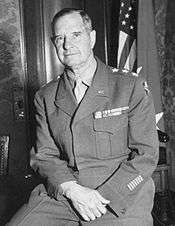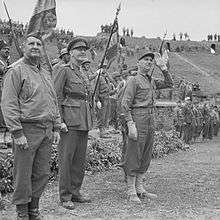Geoffrey Keyes
Lieutenant General Geoffrey T. Keyes (October 30, 1888 – September 17, 1967) was a highly decorated senior United States Army officer who served with distinction in Sicily and Italian Campaign during World War II.
Geoffrey Keyes | |
|---|---|
 | |
| Born | October 30, 1888 Fort Bayard, New Mexico, United States |
| Died | September 17, 1967 (aged 78) Walter Reed Hospital, Washington, D.C., United States |
| Buried | West Point Cemetery, West Point, New York, United States |
| Allegiance | |
| Service/ | |
| Years of service | 1913–1950 |
| Rank | |
| Unit | |
| Commands held | 9th Armored Division I Armored Corps II Corps Seventh Army Third Army |
| Battles/wars | Pancho Villa Expedition World War I World War II |
| Awards | Distinguished Service Cross Army Distinguished Service Medal (3) Legion of Merit Silver Star (2) Bronze Star |
Biography
Early life and military career
Keyes was born on October 30, 1888 in Fort Bayard, New Mexico, the son of Captain Alexander S. B. Keyes, a United States Army officer, and his wife, Virginia Maxwell Keyes. Like his father, Geoffrey enrolled as a cadet at the United States Military Academy (USMA) at West Point, New York on March 2, 1908 and graduated on June 12, 1913, being commissioned as a second lieutenant, into the Cavalry Branch of the U.S. Army. Among his fellow graduates were Charles H. Corlett, Alexander Patch and Willis D. Crittenberger. His first assignment was with the 6th Cavalry Regiment, where he served until October 1916 and participated in the Pancho Villa Expedition.
His next assignment was at the USMA, where he served as an instructor of French language. He was also head football coach for one season in 1917, compiling a record of 7–1. During World War I he served in the United States as an instructor at the USMA.
Between the wars
His interwar service included duty with Panama Canal Division as an Assistant Chief of Staff (G-3), instructor at the USMA and the U.S. Army Cavalry School at Fort Riley, Kansas and Chief of Supply of Supply Division within War Department. He also graduated from the U.S. Army Command and General Staff School in 1926 and the U.S. Army War College in 1937.
World War II
In 1940, during World War II, he was chief of staff of the 2nd Armored Division, which was then commanded by Major General George S. Patton who, like Keyes, was a fellow cavalryman who had served with great distinction in World War I and had taken a significant interest in armored warfare. Patton was to think highly of Keyes, later stating that he "had the best tactical mind of any officer I know."
In January 1942, a month after the Japanese attack on Pearl Harbor on December 7, 1941 and the subsequent German declaration of war on the United States, on December 11, Keyes, now promoted to the one-star general officer rank of brigadier general, he assumed command of Combat Command 'B' (CCB) of the 3rd Armored Division. In July, now a two-star major general, he raised the 9th Armored Division and, in September, he relinquished command of the division to Major General John W. Leonard, before going to North Africa as deputy commander of the I Armored Corps, commanded by Patton, which was later redesignated the U.S. Seventh Army for the Allied invasion of Sicily.

Keyes was originally serving as deputy commander of the Seventh Army during the campaign, once again serving under Patton, in July 1943. During Operation Husky, when Patton split the Seventh Army in half, Keyes was given command of the Provisional Corps, composed of the 2nd Armored Division, the 3rd Infantry Division and the 82nd Airborne Division, along with two U.S. Army Ranger battalions, and supporting units. Advancing 125 miles in five days, through difficult mountainous terrain, the corps captured most of Western Sicily, including Palermo, the Sicilian capital, along with some 53,000 Axis soldiers, mainly Italians, along with nearly 600 vehicles, in exchange for less than 300 casualties. The corps then settled down for garrison duties and the administration of western Sicily until it was disbanded on August 20, three days after the end of the campaign. For his actions in the brief Sicilian campaign Keyes was awarded the Army Distinguished Service Medal. General Dwight D. Eisenhower, the Supreme Allied Commander in the Mediterranean Theater of Operations (MTO) wrote to General George Marshall, the U.S. Army Chief of Staff, noting that his "reports on Keyes as an acting corps commander in the Sicilian affair was most favorable".
In September 1943 he assumed command of the II Corps from Major General John P. Lucas and commanded it throughout the Italian Campaign, landing in Italy in mid-November and serving under Lieutenant General Mark W. Clark's U.S. Fifth Army. Clark, who was eight years younger than Keyes, had been a fellow student at the U.S. Army War College in the late 1930s. His first major battle was the Battle of San Pietro Infine and later, with Major General Fred L. Walker's 36th Infantry Division under command, his corps took part in the controversial Battle of Rapido River, part of the first Battle of Monte Cassino. The corps sustained heavy losses in the battle. The corps was then involved in Operation Diadem, the fighting on the Gothic Line and the Spring 1945 offensive in Italy, which ended the fighting in Italy.
Postwar
After the war he commanded the Seventh Army from 1945 to 1946. In December 1945 he was by his friend George S. Patton's side when he died. This was followed by command of the Third Army, Patton's former command, from 1946 to 1947. In 1947, Keyes was appointed U.S. High Commissioner on the Allied Council for Austria. He served as Director, Weapons Systems Evaluation Group (WSEG) from 1951 to 1954.
Keyes retired from the army in 1954, after 41 years of service, and died on September 17, 1967 at Walter Reed Hospital in Washington, D.C., just a few weeks short of his 79th birthday.[1] He is interred at West Point, New York.
Decorations
Lieutenant general Keyes's ribbon bar:
| 1st Row | Army Distinguished Service Medal w/ two Oak Leaf Clusters | Silver Star w/ Oak Leaf Cluster | Legion of Merit | |||||||||||||
|---|---|---|---|---|---|---|---|---|---|---|---|---|---|---|---|---|
| 2nd Row | Bronze Star Medal | Mexican Service Medal | World War I Victory Medal | American Defense Service Medal | ||||||||||||
| 3rd Row | American Campaign Medal | European-African-Middle Eastern Campaign Medal w/ one silver and two bronze service stars | World War II Victory Medal | Army of Occupation Medal | ||||||||||||
| 4th Row | National Defense Service Medal | Honorary Companion of the Order of the Bath (United Kingdom) | Commandeur of the Legion of Honour | French Croix de guerre 1939–1945 w/ palm | ||||||||||||
| 5th Row | Grand Officer of the Order of Ouissam Alaouite | Grand Officer of the Order of Saints Maurice and Lazarus (Italy) | Silver Medal of Military Valor (Italy) | Grand Officer of the Military Order of the White Lion | ||||||||||||
| 6th Row | Czechoslovak War Cross 1939-1945 | Military Order of Savoy (Italy) | Papal Lateran Cross (Vatican) | Officer of the Legion of Honour | ||||||||||||
Head coaching record
| Year | Team | Overall | Conference | Standing | Bowl/playoffs | ||||
|---|---|---|---|---|---|---|---|---|---|
| Army Cadets (Independent) (1917) | |||||||||
| 1917 | Army | 7–1 | |||||||
| Army: | 7–1 | ||||||||
| Total: | 7–1 | ||||||||
References
- AP (September 19, 1967). "GEOFFREY KEYES, COMBAT LEADER; Commanding General of 2d Corps in Italy Dies at 78" (PDF). The New York Times. Retrieved August 10, 2011.
External links
| Wikimedia Commons has media related to Geoffrey Keyes. |
| Military offices | ||
|---|---|---|
| Preceded by New post |
Commanding General 9th Armored Division June 1942 – September 1942 |
Succeeded by John W. Leonard |
| Preceded by John P. Lucas |
Commanding General II Corps 1943–1945 |
Succeeded by Post deactivated |
| Preceded by Wade H. Haislip |
Commanding General Seventh Army 1945–1946 |
Succeeded by Oscar Griswold |
| Preceded by Lucian Truscott |
Commanding General Third Army 1946–1947 |
Succeeded by Ernest N. Harmon |